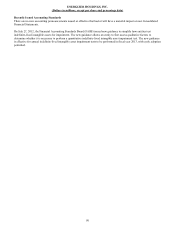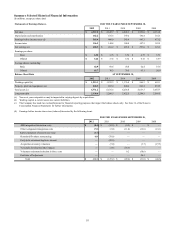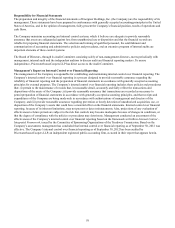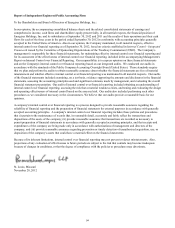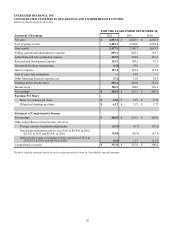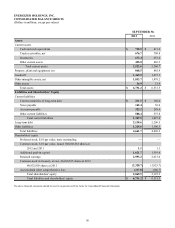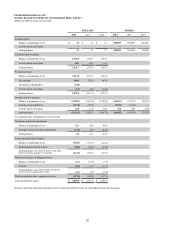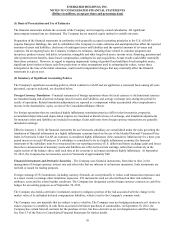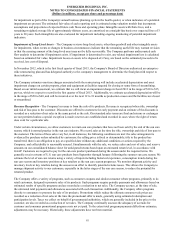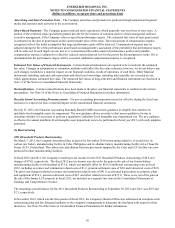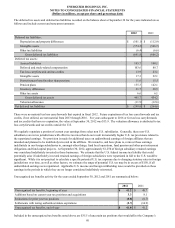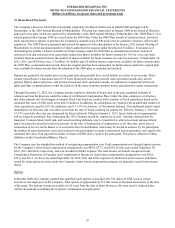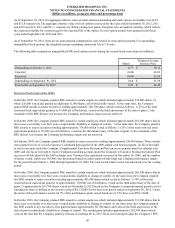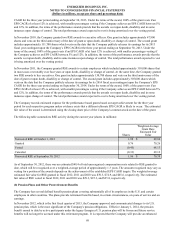Energizer 2012 Annual Report Download - page 70
Download and view the complete annual report
Please find page 70 of the 2012 Energizer annual report below. You can navigate through the pages in the report by either clicking on the pages listed below, or by using the keyword search tool below to find specific information within the annual report.
ENERGIZER HOLDINGS, INC.
NOTES TO CONSOLIDATED FINANCIAL STATEMENTS
(Dollars in millions, except per share and percentage data)
The Company has interest rate risk with respect to interest expense on variable rate debt. The Company is party to an interest
rate swap agreement with one major financial institution that fixes the variable benchmark component (LIBOR) of the
Company’s interest rate on the vast majority of the remaining term loan balance of $100 at September 30, 2012.
For further discussion see Note 13 of the Notes to Consolidated Financial Statements.
Cash Equivalents - For purposes of the Consolidated Statements of Cash Flows, cash equivalents are all considered to be
highly liquid investments with a maturity of three months or less when purchased. At September 30, 2012, the Company had
$718.5 in available cash, the vast majority of which was outside of the U.S.
Cash Flow Presentation - The Consolidated Statement of Cash Flows are prepared using the indirect method, which reconciles
net earnings to cash flow from operating activities. The reconciliation adjustments include the removal of timing differences
between the occurrence of operating receipts and payments and their recognition in net earnings. The adjustments also remove
cash flows arising from investing and financing activities, which are presented separately from operating activities. Cash flows
from foreign currency transactions and operations are translated at an average exchange rate for the period. Cash flows from
hedging activities are included in the same category as the items being hedged, which is primarily operating activities. Cash
payments related to income taxes are classified as operating activities.
Accounts Receivable Valuation – Accounts receivable are stated at their net realizable value. The allowance for doubtful
accounts reflects the Company’s best estimate of probable losses inherent in the receivables portfolio determined on the basis
of historical experience, specific allowances for known troubled accounts and other currently available information. Bad debt
expense is included in Selling, general and administrative expense (SG&A) in the Consolidated Statements of Earnings and
Comprehensive Income.
Inventories - Inventories are valued at the lower of cost or market, with cost generally being determined using average cost or
the first-in, first-out (FIFO) method.
As part of the American Safety Razor (ASR) acquisition in fiscal 2011, the Company recorded an increase in the estimated fair
value of inventory of $7.0, to bring the carrying value of the inventory purchased to an amount which approximated the
estimated selling price of the finished goods on hand at the acquisition closing date less the sum of (a) costs to sell and
distribute and (b) a reasonable profit allowance for these efforts by the acquiring entity. As the inventory was sold during the
first and second quarter of fiscal 2011 the adjustments were charged to cost of products sold in those respective periods.
Capitalized Software Costs - Capitalized software costs are included in other assets. These costs are amortized using the
straight-line method over periods of related benefit ranging from three to seven years. Expenditures related to capitalized
software are included in the Capital expenditures caption in the Consolidated Statements of Cash Flows. Amortization expense
was $2.7, $5.2, and $5.8 in fiscal 2012, 2011 and 2010, respectively.
Property, Plant and Equipment, net – Property, plant and equipment, net is stated at historical costs. Property, plant and
equipment acquired as part of a business combination is recorded at estimated fair value. Expenditures for new facilities and
expenditures that substantially increase the useful life of property, including interest during construction, are capitalized and
reported in the Capital expenditures caption in the Consolidated Statements of Cash Flows. Maintenance, repairs and minor
renewals are expensed as incurred. When property is retired or otherwise disposed of, the related cost and accumulated
depreciation are removed from the accounts, and gains or losses on the disposition are reflected in earnings. Depreciation is
generally provided on the straight-line basis by charges to pre-tax earnings at rates based on estimated useful lives. Estimated
useful lives range from two to 25 years for machinery and equipment and three to 30 years for buildings and building
improvements. Depreciation expense was $136.7, $154.5, and $119.3 in fiscal 2012, 2011 and 2010, respectively.
Estimated useful lives are periodically reviewed and, when appropriate, changes are made prospectively. When certain events
or changes in operating conditions occur, asset lives may be adjusted and an impairment assessment may be performed on the
recoverability of the carrying amounts.
For further discussion regarding asset impairment and the change in the useful life of certain assets due to our 2013
restructuring plan, see Note 20 of the Notes to Consolidated Financial Statements.
Goodwill and Other Intangible Assets - Goodwill and indefinite-lived intangibles are not amortized, but are evaluated annually
60


